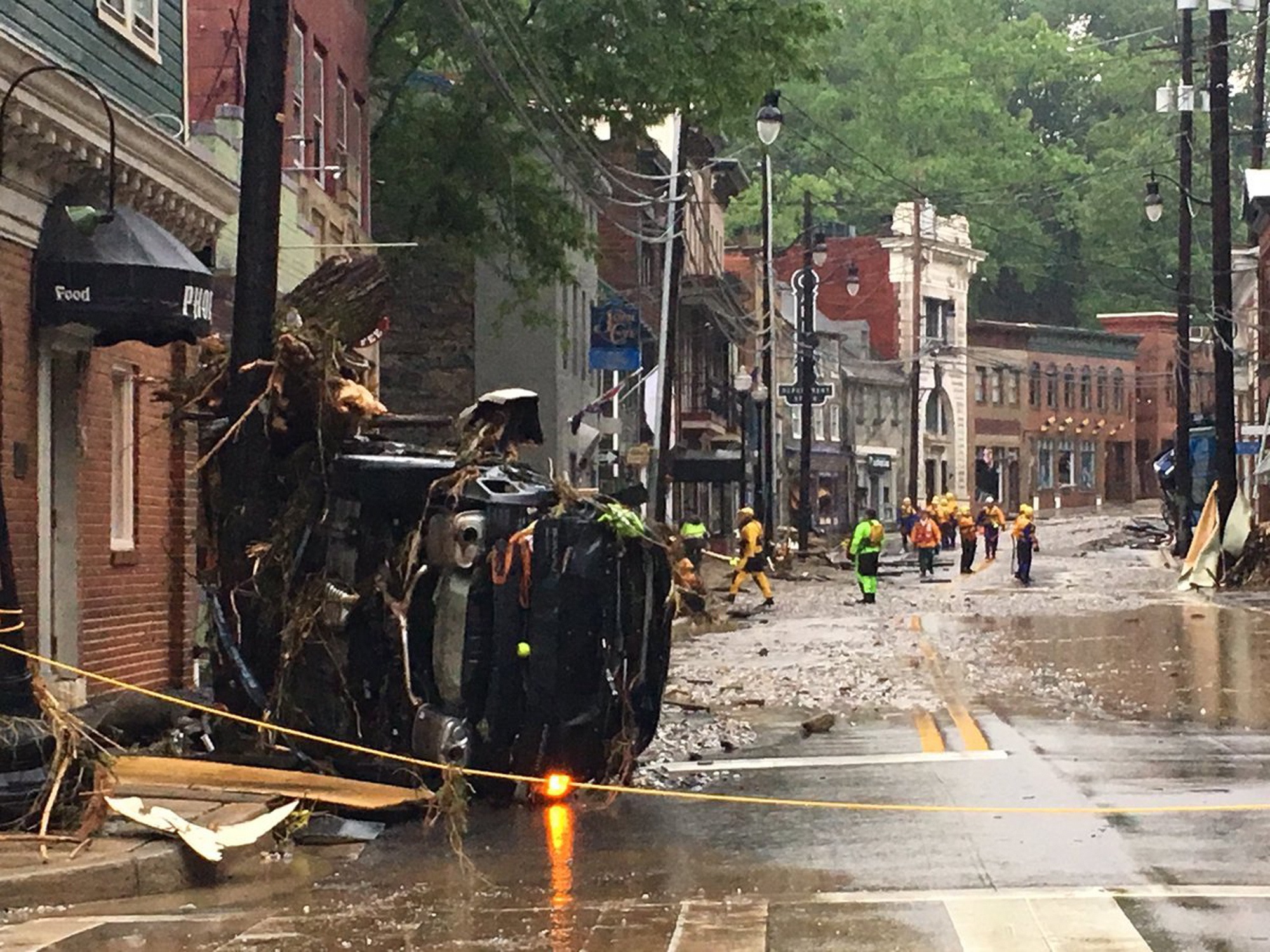Recovery from the flooding in Ellicott City has been long and difficult, and communities have often been left with more questions than answers. UMBC Magazine sat down with experts in public policy and emergency health services for some insight into policy issues and options for flood hazard management. Included are Susan Sterett, director of the School of Public Policy, on the role of public policy in natural disasters; John Rennie Short, public policy, researcher of urban infrastructure; Ryan Miller’99, emergency health services (EHS), former director of emergency management director and deputy chief of fire and rescue for Howard County; and Matt Levy‘00, M.S. ‘08, emergency health services, medical director for EHS, and medical director of Howard County Fire and Rescue Services.
By Catalina Sofia Dansberger Duque
Could you tell us about your emergency response to the Ellicott City floods?
Levy: Our 911 operators and dispatchers are some of the biggest heroes of the Ellicott City Floods that most people won’t know about. They were the ones managing the phone lines and keeping people calm, giving them direction about what to do and not do as flood waters were rising and people were rightfully panicking and scared.
Once our responders received notification, they went into immediate response mode, which is to rescue and to get people out of harm’s way. We train for this. Our responders will risk their lives to try to affect rescues if it is technically feasible and capable. That is not just us but firefighters, police officers, sheriff deputies, and anyone who is responsible for getting people out of harm’s way. Rescuers from the lay public also help – neighbors helping neighbors.
We have the right equipment and use a variety of strategies and tactics to affect as many rescues as possible. Our responders have flotation devices on their apparatus to safely make entry into that environment as well as boats, rigging to remove people, and aerial ladders on trucks to reach people.There are also specially trained swift water rescue teams. The immediate response is to rescue everyone with as many strategies as possible. Once the immediate rescues are done, there is an ongoing process to try to determine that everyone is accounted for.
Eventually we shift to recovery. Once those rescues are made there is a methodical process of assessing the damage to structures after water has rescinded. We look for any potential survivors or casualties and provide a degree of stabilization of those structures to minimize the chance of secondary collapse while our personnel are in them until they can be safely turned over to private contractors who take over that work. Responder work is not as iconic as the media makes it to seem but the work is very important. We continuously train for this and are always looking for improvement to prepare for whatever may come.
What was your role in rescue operations? And how do you work with local government to create policy changes?
Miller: I have been part of three Ellicott City floods. The first one was in 2012. It was associated with Tropical Storm Lee. That is when I personally saw the hazards associated with Ellicott City and flash flooding. It was a relatively minor storm now that we have 2016 and 2018 in perspective. Tropical Storm Lee causes roadway flooding and set off a lot of planning and mitigation planning within the county. It was the predecessor to the 2016 and 2018 which were severe.
Our role in both storms was to set up the emergency operation center in Ellicott City and bring together all the county agencies toward a common response goal and lead the recovery. We also work with the State of Maryland and the Maryland Emergency Management Agency to pull in resources from outside of the region and outside the state and interact with the Federal Emergency Management Agency (FEMA) and all federal agencies that are brought in resources to assist us. After the initial response, we chart the recovery plan, which can be anywhere between six months to a year. Howard County is unique in that we had a similar disaster twice in a short period of time. Alot of our plans and systems that we created in 2016 helped in 2018.
During emergencies, the directors work side by side with the county executive who creates policy. The director then has delegated authority or direct authority to coalesce those county resources toward a response. We are appointed by the governor, so should there be a catastrophic event, the governor can then work through the 26 directors to affect statewide responses and recovery.
What is the impact of floods on local governments? And are there policies that can be implemented to help prevent flooding?
Sterett: It is a challenge for local governments to restrict development in flood-prone zones. Even if there is a potential for risk at the national level, local governments have reasons to want people to rebuild in flood-prone zones because they depend on property taxes. It is also an issue in areas that are fire risks like in California or Arizona where people build in areas where they don’t have access to the water that they need.
We need to be aware of changes in extreme weather events and rethink the National Flood Insurance program. The insurance models need to be reevaluated so that insurance can be priced accordingly.
Building codes would make a difference, but we need to evaluate overbuilding in areas that are at tremendous risk. Local governments need to work with developers to build communities that reduce risks. However, this is not simple. Implementing accurate government maps of flood levels would decrease property values drastically and local government taxes. There is no easy answer.
We also must think of renters and how they are affected by extreme weather. Owners have a range of choices in a devastating situation, but renters are not in control of whether their home will be rebuilt. It is also important to take into account how disasters can deepen existing racial and economic inequalities.
So much of this is about land-use planning. We don’t have a big national plan, and we are not getting rid of flood insurance. Local governments can help by developing adaptation plans as climate changes and more extreme weather occurs.
Is there a model in the U.S. to look towards?
Sterett: Many local governments have adaptation plans developed with the help of different city departments. The Rockefeller 100 Resilient Cities, a non-profit organization, brings people together to think systematically about environmental problems. They fund a resilience officer who provides support and guidance as cities recover from a disaster.
Norfolk, Virginia can also be an example even though it has a military base. The city has a committed local government that has a multipronged plan. It tries to take advantage of every opportunity to engage the community in its adaptation plan. They hold fun community celebrations like “Retain Your Rain,” to encourage rain barrel use, and bring the public into decisions on how they repave, where public housing is built, and how traffic is guided.
It is important to approach public problems with awareness of what the problems are, a bit of hope, and a commitment to try to work on various parts. There is no quick fix. Addressing flooding across different communities is a complicated issue that depends on collaboration between governments, residents, business owners, developers, and environmentalists.
Is there a connection between flooding and global climate change?
Short: It is impossible to discuss flooding without talking about global climate change. When you have two, one-in-a-thousand-year flood, 22 months apart, it creates a new normal. Higher frequency of extreme events like larger hurricanes, longer lasting storm seasons, and more snow make cities more vulnerable to flooding.
What is the relationship between development and long-term environmental impact?
Short: Suburban tracks are everywhere. Acres upon acres of roads, sidewalks, strip malls, housing, and parking lots, all create an impermeable surface leaving water nowhere to go. When you have a green field and it rains two to three inches, you can get some flooding, but it can get absorbed. Cement does not absorb large amounts of water— it just runs off.
This happens because developers push the envelope, local authorities want the revenue, and politicians want the notion of growth. There is so much growth without any sense of the long-term environmental impact. Research has shown that when more impermeable surfaces are built, there is a higher risk of flooding.
Ellicott City is very vulnerable because of its location. It originally was placed there because it was needed for hydraulic power for the mill. Over time, it became more vulnerable because of increased development in the watershed and ignored infrastructural deficits, which, when paired with larger, more frequent storms, created catastrophic events.
*****
Read more: Learning from Ellicott City
Read more: A Timeline of Resilience
Header image: EHS workers respond to the scene in Ellicott City. Permission from Baltimore Sun Media. All rights reserved.
Tags: EHS, PublicPolicy, Spring 2019




